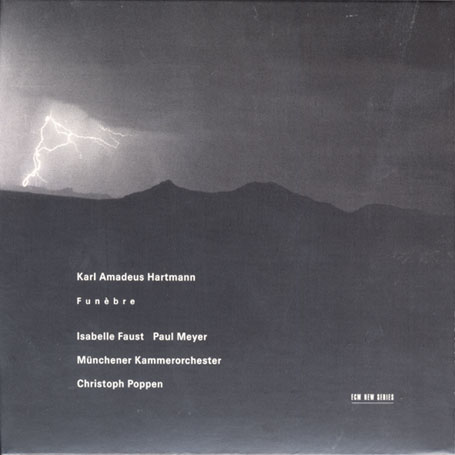Hartmann Concerto funebre
Internalised indignation at the horrors of a fatefully flawed political regime leads here to elevated art – and not merely to musical reportage. Fine performances, especially from Isabelle Faust
View record and artist detailsRecord and Artist Details
Composer or Director: Karl Amadeus Hartmann
Genre:
Orchestral
Label: ECM New Series
Magazine Review Date: 12/2000
Media Format: CD or Download
Media Runtime: 78
Mastering:
DDD
Catalogue Number: 465 779-2

Tracks:
| Composition | Artist Credit |
|---|---|
| Concerto funèbre |
Karl Amadeus Hartmann, Composer
Christoph Poppen, Conductor Isabelle Faust, Violin Karl Amadeus Hartmann, Composer Munich Chamber Orchestra |
| Symphony No. 4 |
Karl Amadeus Hartmann, Composer
Christoph Poppen, Conductor Karl Amadeus Hartmann, Composer Munich Chamber Orchestra |
| Chamber Concerto |
Karl Amadeus Hartmann, Composer
Christoph Poppen, Conductor Karl Amadeus Hartmann, Composer Munich Chamber Orchestra Paul Meyer, Clarinet Petersen Quartet |
Author: Rob Cowan
When Karl Amadeus Hartmann opted for internal exile during the Nazi era, he took with him some key influences from the free musical world. Beam up around 0'33'' into the third movement of the 1939 Concerto funebre (track 3) and you have a virtual quote from the first movement of Bartok’s 1934 Fifth String Quartet. Hartmann completed his Chamber Concerto for Clarinet, String Quartet and String Orchestra in 1935, seven years after Bartok wrote his Fourth Quartet – which in turn barges headlong into Hartmann’s second movement (0'07'' into track 9, an unmistakable reference to the Quartet’s finale). And I can’t resist drawing attention to a third specific musical parallel, again in the Chamber Concerto. The first movement’s melodic and structural profile follows the profile of Kodaly’s 1933 Dances of Galanta (try following through from 1'09'' until around 3'22'' into track 8, taking particular note of the clarinet line).
The Chamber Concerto had to wait 34 years for its premiere (in 1969) though I cannot imagine why it hasn’t become a repertory mainstay. The language is Magyar-inspired (even aside from the Galanta references) and the scoring lively and luminous. The Concerto funebre opens with a quotation (fully acknowledged this time) of the Hussite chorale ‘Ye Who are God’s Warriors’, best known to us Brits for its use in Smetana’s Ma vlast. The reference commemorates the Nazi betrayal of Czechoslavakia, though Hartmann’s anger finds controlled expression in the Allegro di molto third movement.
The Fourth Symphony is scored for strings and frames a lively Allegro di molto with two profound Adagios that, again, draw you in by virtue of their intense arguments. All three performances do Hartmann proud. Isabelle Faust’s eloquent playing of the Concerto funebre draws maximum effect from extremes in mood and temperature. Thomas Zehetmair and the drier-toned Andre Gertler are her strongest competitors, though neither strikes me as in any way preferable. Rafael Kubelik offers an admirably pliant live account of the Fourth Symphony, and while Ingo Metzmacher’s Fourth is occasionally more intense than this new version under Christoph Poppen (especially in the unison opening pages), Poppen’s central Allegro has the stronger sense of propulsion.
With fine sound and imaginative programming, ECM has here given us the ideal Hartmann primer. Let’s hope that their collaboration with the Munich Chamber Orchestra will allow for further forays into the output of this great but still sadly unsung Munich master.'
The Chamber Concerto had to wait 34 years for its premiere (in 1969) though I cannot imagine why it hasn’t become a repertory mainstay. The language is Magyar-inspired (even aside from the Galanta references) and the scoring lively and luminous. The Concerto funebre opens with a quotation (fully acknowledged this time) of the Hussite chorale ‘Ye Who are God’s Warriors’, best known to us Brits for its use in Smetana’s Ma vlast. The reference commemorates the Nazi betrayal of Czechoslavakia, though Hartmann’s anger finds controlled expression in the Allegro di molto third movement.
The Fourth Symphony is scored for strings and frames a lively Allegro di molto with two profound Adagios that, again, draw you in by virtue of their intense arguments. All three performances do Hartmann proud. Isabelle Faust’s eloquent playing of the Concerto funebre draws maximum effect from extremes in mood and temperature. Thomas Zehetmair and the drier-toned Andre Gertler are her strongest competitors, though neither strikes me as in any way preferable. Rafael Kubelik offers an admirably pliant live account of the Fourth Symphony, and while Ingo Metzmacher’s Fourth is occasionally more intense than this new version under Christoph Poppen (especially in the unison opening pages), Poppen’s central Allegro has the stronger sense of propulsion.
With fine sound and imaginative programming, ECM has here given us the ideal Hartmann primer. Let’s hope that their collaboration with the Munich Chamber Orchestra will allow for further forays into the output of this great but still sadly unsung Munich master.'
Discover the world's largest classical music catalogue with Presto Music.

Gramophone Digital Club
- Digital Edition
- Digital Archive
- Reviews Database
- Full website access
From £8.75 / month
Subscribe
Gramophone Full Club
- Print Edition
- Digital Edition
- Digital Archive
- Reviews Database
- Full website access
From £11.00 / month
Subscribe
If you are a library, university or other organisation that would be interested in an institutional subscription to Gramophone please click here for further information.




